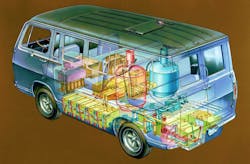A Short History of the First Hydrogen Fuel Cell Vehicle
The Batmobile and the Star Trek Enterprise got more attention in 1966. But the Electrovan, a General Motors Handivan converted into the world’s first hydrogen fuel cell vehicle, was the real space-age marvel.
According to GM’s Heritage Center, fuel cells have been around since the early 1800s, but this was the first fuel cell on wheels. The vehicle topped out at 70 mph and had a range of about 150 miles. Safety concerns limited its trips to company property.
A lot of technology was crammed into a relatively small space. The vehicle’s motor and control system were mounted between and under the two front seats. Thirty-two fuel cell modules connected with 550 feet of plastic piping fit under the floor. Cryogenic hydrogen and oxygen tanks and an electrolyte reservoir were mounted behind the middle bench seat.The Electrovan had a top speed of 70 MPH and could squeeze in a driver and two passengers. It could accelerate from 0-60 MPH in 30 seconds and had a range of approximately 150 miles. Because of safety concerns, the Electrovan was only used on company property.
The vehicle was innovative but not practical: the platinum in the fuel cell alone cost as much as an entire fleet of vans. And there was no real infrastructure for charging the vehicle (sort of like now).
Floyd Wyczalek, the nonagenarian former project manager of Electrovan fuel cell development at GM, recalled that three shifts of team members worked on the project beginning in January 1966 and finishing in October. The project was the first to transfer fuel-cell technology from NASA's Apollo mission into other applications.
After the project ended, the Electrovan was stored in a Pontiac, Michigan, warehouse for 31 years before being rediscovered in 2001 and brought out for fuel cell displays and museum shows when not parked at the GM Heritage Center.
About the Author

Laura Putre
Senior Editor, IndustryWeek
As senior editor, Laura Putre works with IndustryWeek's editorial contributors and reports on leadership and the automotive industry as they relate to manufacturing. She joined IndustryWeek in 2015 as a staff writer covering workforce issues.
Prior to IndustryWeek, Laura reported on the healthcare industry and covered local news. She was the editor of the Chicago Journal and a staff writer for Cleveland Scene. Her national bylines include The Guardian, Slate, Pacific-Standard and The Root.
Laura was a National Press Foundation fellow in 2022.
Got a story idea? Reach out to Laura at [email protected]
